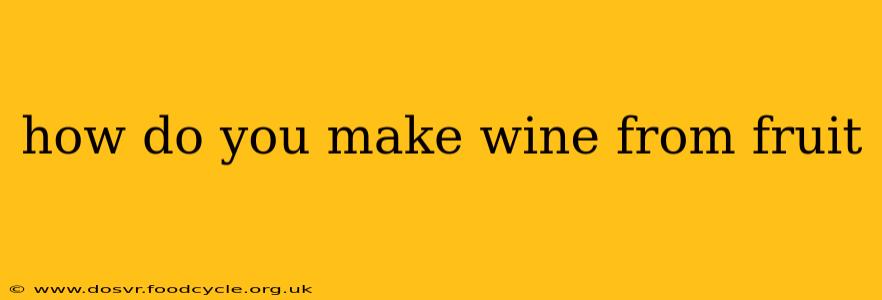Making wine at home is a rewarding experience, allowing you to transform fresh fruit into a delicious, personalized beverage. While grapes are the most common fruit for winemaking, many other fruits can be used to create unique and flavorful wines. This guide will walk you through the process, providing insights into each step for successful fruit winemaking.
What Fruits Can You Use to Make Wine?
Almost any fruit with sufficient sugar content can be used for winemaking. Popular choices beyond grapes include:
- Berries: Strawberries, raspberries, blueberries, blackberries, and cranberries all yield distinctive wines.
- Stone Fruits: Peaches, plums, cherries, and apricots offer unique flavor profiles.
- Other Fruits: Apples, pears, melons, and even prickly pears can be used, though some may require adjustments to the process.
The success of your wine will depend heavily on the quality and ripeness of the fruit. Choose ripe, healthy fruit free from mold or blemishes.
Step-by-Step Guide to Fruit Winemaking
The process, while detailed, is manageable for home winemakers. Here's a breakdown:
1. Preparation:
- Cleaning and Sorting: Thoroughly wash and sort your fruit, removing any damaged or spoiled pieces.
- Crushing: Crush the fruit to release the juice. You can use a potato masher, a food processor (pulse gently to avoid over-processing), or even your hands for smaller batches.
- Measuring Sugar: The sugar content of your fruit will dictate the final alcohol content of your wine. A hydrometer is invaluable for accurately measuring the sugar (measured as Brix or specific gravity). You might need to add sugar (usually granulated white sugar) to reach the desired level depending on the fruit's natural sweetness.
2. Fermentation:
- Adding Yeast: Wine yeast is essential for converting sugar into alcohol and carbon dioxide. Choose a yeast strain appropriate for the type of fruit you're using. Follow the yeast manufacturer's instructions for activation and adding to the must (the crushed fruit mixture).
- Primary Fermentation: This is the main fermentation phase, typically lasting several days to a few weeks. During this time, the yeast will actively convert sugars into alcohol, producing carbon dioxide and heat. It's crucial to maintain proper temperature control (ideally around 65-75°F or 18-24°C) to prevent off-flavors. Use an airlock to allow CO2 to escape while preventing oxygen from entering.
- Secondary Fermentation (Optional): After primary fermentation, you may choose to rack (transfer) the wine to a secondary fermenter. This allows for clearer wine and continued aging.
3. Aging and Bottling:
- Aging: Allow the wine to age for a period of time, which can vary from a few months to several years depending on the fruit and your desired taste profile. Aging mellows the tannins and allows the flavors to develop.
- Bottling: Once the wine has reached your desired level of clarity and flavor, bottle it. Ensure your bottles are clean and sterilized. Seal tightly with corks or bottle caps.
What Are The Key Differences Between Making Wine From Grapes and Other Fruits?
While the fundamental process is similar, key differences exist:
- Sugar Content: Grapes generally have a higher sugar content than most other fruits, often requiring less added sugar.
- Acid Levels: Many fruits have lower acidity than grapes, so you might need to add acid blend (tartaric acid) to balance the sweetness and prevent spoilage.
- Tannin Levels: Grapes provide natural tannins, which contribute to the wine's structure and mouthfeel. Many fruits have far less, requiring different approaches to achieve a balanced wine.
- Pectin Levels: Some fruits, like berries, contain high levels of pectin, which can cause cloudiness. Pectin enzyme can be added to help clarify the wine.
How Long Does It Take To Make Fruit Wine?
The time it takes to make fruit wine varies based on the fruit used, the fermentation process, and the aging period. Expect a minimum of several months, possibly longer for a smoother, more complex final product. The aging process can significantly enhance the taste.
What Equipment Do I Need To Make Wine From Fruit?
Essential equipment includes:
- Fermenter: A large food-grade container (glass or food-grade plastic) for fermentation.
- Airlock: Allows CO2 to escape while preventing oxygen from entering.
- Hydrometer: Measures the sugar content of the must.
- Bottles and Corks/Caps: For bottling.
- Siphon tubing: For racking the wine.
- Sanitizing solution: To sterilize equipment.
Making fruit wine is a journey of experimentation and discovery. Enjoy the process and learn from each batch! Remember to always follow safe food handling practices and adhere to local regulations regarding alcohol production.
